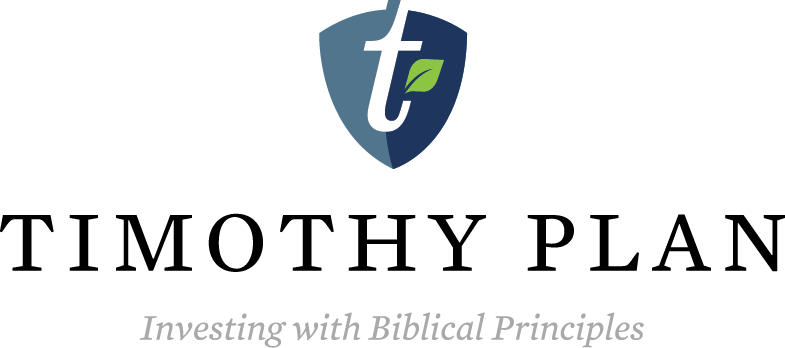Fixed Income & High Yield Bond 2Q18
June 30, 2018
Recent Posts
- A Businessman Who Really Did Give it All Over to GodSeptember 28, 2022
- A 'Screwtape' Approach to Keeping Christians from Biblically Responsible InvestingSeptember 21, 2022
- Both Inflation and Inaction Are UnbiblicalSeptember 14, 2022
- Misunderstood in the NeighborhoodAugust 18, 2022
- Billy Graham was the inspiration for the new BiblegraphAugust 9, 2022
- A Businessman Who Really Did Give it All Over to God
Categories

Investing involves risk, including the potential loss of principal.
Before investing, carefully consider the fund’s investment objectives, risks, charges, and expenses of the investment company. This and other important information can be found in the fund’s prospectus. To obtain a copy, visit TIMOTHYPLAN.COM or call 800.846.7526. Read each prospectus carefully before investing.
Because the Timothy Plan Funds do not invest in excluded securities, the Funds may be riskier than other funds that invest in a broader array of securities. There are risks when a fund limits its investments to particular sized companies, and all companies are subject to market risk. The Fund recently experienced significant negative short-term performance due to market volatility associated with the Covid-19 pandemic.
MUTUAL FUND INVESTOR
To read more about our mutual funds, please click this link to access fund information, including the prospectus, fact sheets, performance, and holdings for each fund.A prospectus is available from the Fund or your financial professional that contains more complete, important information. Please read it carefully before investing. Mutual Funds distributed by Timothy Partners, Ltd. Member FINRA.
HEADQUARTERS: 1055 Maitland Center Commons, Maitland, FL
(800) 846-7526 | Send an email | View our mapMUTUAL FUND SHAREHOLDER SERVICES: c/o Ultimus Fund Solutions, Post Office Box 541150, Omaha, NE 68154-1150
(800) 662-0201 | Account AccessETF INVESTOR
To read more about our ETFs, please click this link to access fund information, including fact sheets, performance and holdings for each fund. A prospectus is available from the Fund or your financial professional that contains more complete, important information. Please read it carefully before investing. ETFs distributed by Foreside Fund Services, LLC, Member FINRA. Timothy Partners, Ltd. is not affiliated with Foreside Fund Services, LLC.
ETF SHAREHOLDER SERVICES: Contact your financial advisor for information regarding your account.






Are we on the verge of yet another “as good as it gets” U.S. economy, or is this the calm before the storm??
2Q18 MARKET REVIEW: Higher U.S. Treasury (UST) yields and wider credit spreads combined to produce losses across much of the fixed income market in 2Q18. The Bloomberg Barclays Aggregate Index suffered a negative total return for the second consecutive quarter in 2Q18.
THE ECONOMY, INTEREST RATES & THE FED: The U.S. Federal Reserve continued on the path of rate normalization in June with the seventh 25 basis point (bp) hike since December 2015. The 2yr UST yield followed the Fed’s lead, rising 26bps to 2.53%, while the 10yr UST yield only rose 12bp to 2.86%. The UST yield curve reached its flattest level since 3Q07.
INVESTMENT GRADE CREDIT: IG Credit was the worst performer among major sectors in the Aggregate Index as 13bps of credit spread widening generated negative excess returns. BHMS maintained an overweight in IG Credit, but our defensive posture dampened the negative effects of 2Q spread widening.
HIGH YIELD: High Yield bonds (Ba/B rated) outpaced IG Credit and posted positive total and excess returns in 2Q18. For the second straight quarter, the Credit Suisse Bank Loan Index registered the best results of all major fixed income sectors with a 0.78% total return, 17bps ahead of HY Ba/B bonds.
AGENCY MBS, ABS & CMBS: Mortgages (MBS) outpaced the performance of Corporates and the Aggregate Index in 2Q18. Asset Backed (ABS) and Commercial Mortgage Backed Securities (CMBS) avoided negative excess returns. BHMS remained underweight in MBS in 2Q18, but is looking to selectively add when MBS spreads move wider.
LONG CREDIT & LDI TRENDS: Higher long UST rates and a steeper credit curve led to Long Credit underperforming Intermediate maturities. Equity gains, which outpaced losses in bonds, and higher long UST yields boosted U.S. pension funding ratios by 1.7%, to an average of 88%.
“Gradualism may be an inappropriate response to a nonlinear process.” – Matthew Klein, Barron’s
THE ECONOMY, INTEREST RATES & THE FED: As expected, the Federal Reserve raised the Fed Funds (FF) rate 25bps at the June 13 FOMC meeting, nudging the target range up to 1.75% 2.00%. The latest move, the second this year and the seventh since 3Q15, maintains the Fed’s intended pace of four rate hikes in 2018 and an anticipated three more in 2019. The fabled “dot plots” point to a FF target of 2.375% in 2019 and 3.125% in 2020, reflecting expectations of stronger economic growth and rising inflation. The combination of a higher FF rate and the Fed’s balance sheet runoff are confirmation of a marginally more hawkish Quantitative Tightening (QT) normalization transition. The “canary in the coal mine” may be the impact on rates across the yield curve from the sharp increase in UST auction supply needed to finance tax cuts and budget deficits.
Additionally, the ECB decided to maintain its current accommodative rate posture through 3Q19, but will end its QE asset purchases at YE18 while still reinvesting cash flows from holdings on its balance sheet. This dovish forward guidance is perhaps an obvious acknowledgment of the growth “soft patch” emerging in 2Q18. The BOJ also confirmed an intent to sustain current accommodation, which is timely in light of their own growth deceleration in 1Q18.
The U.S. economy continues to evidence low unemployment and solid job creation. However, the conundrum is still low wage pressures, even as workers are emboldened enough to quit a current job to find better pay elsewhere. Consequently, the absence of wage inflation contributes to contained inflation. Oil prices have firmed above $65 (WTI) and the most recent inflation data (May) shows the Fed’s 2.0% Core PCE target has been attained for the first time since April 2012. But autos and housing, both good barometers of economic health, show signs of stalling. Existing home sales fell below expectations at -3% YoY in May, with every region down or flat YoY. With 30-yr mortgage rates generally +70bps higher YTD18 to a recent 4.65%, any sustained increase in inventories, and slowing in both sales and price gains, could signal a turn in housing.
OUTLOOK: Current projections favor moderate acceleration in GDP, further job gains, and a gradual lift in domestic price pressures. These forecasts support more Fed rate hikes in 2018 2019 and a terminal FF rate of 3.00%. Continued gradual restraint in Fed policy may further flatten the yield curve. At 33bps between 2-Yr/10-Yr UST yields, the curve could invert by YE18. Time will tell if such an inversion proves to be the historical harbinger of a recession, but a further firming in Fed policy will support USD strength and increased foreign investor demand.
“What we know can be equally, if not more, important than what we don’t know.” – Steven Ricchiuto, Mizuho
INVESTMENT GRADE CREDIT MARKET REVIEW: Through 1H18, Investment Grade (IG) corporate bonds have significantly underperformed other asset classes, generating the worst 1H total return (-3.16%) since 1994. The culprit has been more related to market technicals than a deterioration in credit fundamentals. New issue supply of $732B YTD assisted in funding accelerated M&A activity, but weak investor demand contributed to wider spreads throughout 1H18. IG Credit posted the weakest excess return (-1.86%) since 2008. Goldman Sachs reports U.S. companies have announced over $674B (43 deals) in YTD18 acquisitions, surpassing the full-year $617B (46 deals) in 2017.
Negative YTD total returns on rising rates and wider spreads have impacted buying by both foreign investors and mutual funds, who collectively have been the largest net buyers of U.S. corporates the past three years. The latest available monthly data (May) shows net fund flows (ex-short term funds) were negative (-$768B) for the first time since September 2015 and a sharp reversal from the strong and steady inflows throughout 2017. Diminished foreign buying was also significantly influenced by increasingly unfavorable currency hedging costs.
These supply/demand dynamics were magnified during 1H18 by the repatriation of foreign cash holdings of U.S. corporations. As referenced in our 1Q18 commentary, cash and marketable securities held on the balance sheet of the top 100 non-financial companies in the S&P 1500 totaled —$1.6T. Post-crisis net purchases of bonds had averaged $30B per quarter until 1Q18. With passage of the 2017 Tax Cut and Jobs Act, corporations had new tax incentives to repatriate off-shore cash. In 1Q18, net sales and maturities totaled only about $100B. The abrupt shift by corporate treasurers from net buyers to net sellers was a significant contributor to the —55% widening in short maturity IG corporate spreads during 1H18.
While the front-end corporate curve improved in 2Q18, the 2017 spread compression low of 81bps in early 2018 has reversed. Corporate spreads finished 1H18 at 123bps, their widest level since 4Q16. IG credit curves have also steepened, noticeably impacting long-duration (25+ years) credit with -270bps of excess return, while Intermediate credit fared better at only -11bps. The best performing sectors were Basic Industry, Capital Goods, and Financials, while Communications and Energy were the worst.
Credit fundamentals currently remain healthy. JPM reports YoY EBITDA growth for four quarters ending 1Q18 was +8.3% (+4.7% ex-commodities). While marginally lower versus YoY 4Q17, it was the strongest performance since 2Q12. Excluding commodities, it was still the best result since 1Q12. Profit margins were flat in 1Q18 at 29.0% but +1.1% YoY, still the highest since 2000.
Driven by improving commodity prices, gross leverage declined from 3.0x in 1Q17 to 2.8x in 1Q18, and interest coverage rose from 10.0x to 10.2x YoY. However, companies have binged on $14T in new debt since the 2008-09 financial crisis and corporate leverage is now 20% higher, highlighting the importance of security selection focused on credit fundamentals.
OUTLOOK: As 2H18 dawns, IG corporate investors will continue to face countervailing influences. While short maturity rates will rise with continued QT measures by the Fed, higher yields and wider spreads versus YE17 provide more attractive valuation opportunities. Of note, 1-3Yr IG yields near 3.35% are 85bps higher YTD and the highest since 2009, but the influence of repatriation on corporate Treasurers as a buyer base may remain a headwind for short-duration IG. Solid economic growth should also continue to support an increase in corporate earnings and credit metrics.
Performance in 2H18 may be more rewarding as market technicals become more favorable. The negative impact of hedging costs on foreign investor demand in 1H18 may be reversing. The divergent paths of U.S. versus foreign central banks has been a positive for the USD. Coupled with higher yields in USD bonds, a return of foreign buyers and mutual fund investors seeking higher yields, plus potential reinvestment of an estimated $79B in monthly interest and maturity flows, should be positive for spreads. New issue supply in 2H18 is also expected to push full-year totals beyond $1.1T, but end the six-consecutive annual issuance record of 2012-2017. A supply wildcard might be funding of the blockbuster AT&T/Time Warner merger and any subsequent momentum to additional outsized deals. Some domestic investors seeking nominal yield may find increasing value in the short end of the credit curve. Others, particularly institutional investors and pension funds, may also find greater opportunities in higher yielding longer paper, especially in a steeper credit curve environment. (See more commentary on pension funding status and demand for long corporate bonds in our Long Duration section.)
BHMS STRATEGY: Maintain current posture for the incremental income, with a look to increase exposure on any further widening in spreads. With spreads now wider by —15bps versus 1Q18 and —26bps versus YE17, valuations in IG corporate bonds are again more reasonable. Still, the threat of heavy M&A-driven new issue supply and rising rates warrant caution in IG corporate exposure. Idiosyncratic risk also still prevails and we continue to closely monitor negative M&Adriven event threats, especially in sectors and individual names which are struggling to grow earnings organically and are dependent on acquisitions to offset secular declines in their businesses. In particular, these sectors include Healthcare, Food & Beverage, Consumer/Retail and Telecom-Media-Technology. Consequently, we continue to favor selective U.S Banks and Energy credits, along with issuers which have already funded growth initiatives.
“In the corporate bond segment of fixed income, you need to avoid the losers.” – Cliff Noreen, MassMutual
HIGH YIELD MARKET REVIEW: In contrast to IG, Ba/B High Yield Credit (HY) has been more resilient in 2Q and 1H18, with total returns of 0.61% and -0.49%, respectively. The primary influence on HY performance has been favorable technicals, particularly a lack of supply. New issue HY volume at $138B YTD is tracking lower by 25% YoY. Key elements in this decline are improved balance sheets, a delayed reaction to new tax rules, a dearth of M&A activity among HY credits, and an increased preference for funding in the Bank Loan (Loan) market. It is a welcome trend to see improving leverage ratios among HY companies, helped by stronger cash flows and an incentive to maintain interest expense deductibility under the new tax law (40% or less of EBITDA). Bank loans also provide pre-payment flexibility for issuers, improved market depth, and increasing demand from investors seeking floating rate assets. As a result, Loans were the best HY performer with total return of 0.78% in 2Q and 2.38% in 1H18.
The majority of new bond supply was used for refinancing of existing legacy debt issues. Goldman Sachs reports the combination of these factors resulted in a $30B deficit in net supply YTD, which benefited performance via a meaningful offset to the $14.5B in cumulative net outflows from HY mutual funds in 1H18. Total loan supply of $370B in 1H18 was only up 1% but M&A-related issuance rose 25% YoY. Fund flows were strong with $8.26B in YTD inflows. In essence, low HY supply offset diminished demand.
HY was not immune to the spread trend in 2Q18, widening a modest 6bps to 339bps, but marginally tighter YTD and within the 311/372bps YTD range. 1H18 closed with HY generating +152bps in excess returns. Across sectors, the best performer was Communications, while the strong post-OPEC meeting rebound in oil prices boosted Energy, and modest gains were posted in Consumer Cyclical and Utility sectors. By rating category, the demand for yield continued to favor CCC issuers (+4.43%), single B issuers (+1.37%), and BB issuers (-0.95%), respectively. BB-rated issues now account for 44% of the HY market (B: 43%; CCC: 13%), and posted the lowestYTD18 total returns, underperforming the broad market by 160bps.
OUTLOOK: HY should continue to enjoy the support of favorable macroeconomic and supply/demand factors. Solid, if not steady, economic growth and improving earnings should sustain credit fundamentals and keep defaults below 2%. HY companies also tend to generate a majority of their revenues from the U.S., an added comfort for investors. As yields are expected to rise in 2H18, the yield advantage of BB/B HY should improve. However, at this later stage of the credit cycle, value in HY is largely isolated to incremental carry as the spread compression relative to IG corporates has likely run its course. In addition, the BBB segment of the IG market now totals $2.4T and the explosive growth in more highly leveraged IG credits.
“Sound and fury signify nothing in a tale told by idiots.” — Shakespeare
AGENCY MBS REVIEW: The mortgage sector withstood the pressures of rising rates, a flatter yield curve, and continued QT to post modestly positive performance in 2Q18. Lower originations and diminished volatility, along with renewed demand from U.S. bank and overseas investors seeking yield and liquidity, influenced 2Q18 performance. The MBS sector’s shorter duration of 5.0 years versus 7.3 years in IG Credit also positively contributed to 2Q18 performance of 0.24% total and 0.15% excess returns. Though positive for 2Q18, YTD total and excess returns remained in negative territory at -0.95% and -0.24%, respectively.
Within the aggregate MBS sector, GNMA issues outperformed Conventional counterparts during 2Q18. Duration was again the key driver of relative performance, as GNMAs typically have shorter durations due to more rapid prepayment characteristics. However, recent GSE policy changes have been successful in mitigating the “churning” behavior of certain VA loan originators. These changes have proven beneficial to higher coupon GNMA securities. By maturity type, 15-yr MBS underperformed 30-yr issues as the bear flattening of the UST yield curve had a more adverse impact on the former’s front-loaded cash flows.
MBS OUTLOOK: The profile of the MBS market has changed since YE17. With higher YTD rates, the average MBS price has declined from 103-03 to 100-16, the duration has extended from 4.4 years to 5.0 years, and the convexity has improved to -1.05% from -1.86%. The combination of these changes makes the risk profile of the MBS sector more attractive for investors. Now that the 10-yr UST yield is 150bps higher than the low reached in July 2016, only 10% of the mortgage universe is currently in the refinance window. The MBA refinance index has now fallen to the lowest level since YE2000. The resulting shrinking origination pipeline and declining net issuance has helped cushion the run-off of the Fed’s portfolio, which is set to increase to $16B in 3Q18 from the current $12B.
BHMS MBS STRATEGY: Maintain underweight but with a view to increase exposure on improved valuations and market technicals. Agency MBS valuations have become more attractive and spreads are currently near multi-year wides. Buyer demand has reversed course from YE17 as sidelined investors are attracted to wider spreads, higher yields, and better risk-reward price and convexity metrics. We are cautiously optimistic but mindful of the Fed’s continuing path of rate hikes and balance sheet reduction. Consequently, we continue to favor up-in-coupon 30yr issues for the carry advantage, reduced duration risk, and lack of sensitivity to the Fed’s balance sheet reduction plan.
ABS MARKET REVIEW & OUTLOOK: For the second consecutive quarter, ABS was one of the best performers among structured products in 2Q18, generating a total return of 0.42% and an excess return of 0.17%. Performance was particularly impacted by the shorter duration profile in a rising rate environment. The Utility subsector was the best performer at 0.65%, followed by Autos at 0.47% and Credit Cards at 0.36%.
Supply increased marginally in 2Q18 to $60B, raising 1H18 totals to $126B. Auto issuance continues to account for the largest share at 43%, up 13% YoY. With Auto sales still registering solid gains, the supply trend should continue through 2H18. Credit Card issuance is 30% lower YoY and comprised only 16% of issuance. Equipment-backed issuance increased 56% YoY and comprise 7% of total YTD issuance.
BHMS ABS STRATEGY: Maintain an overweight on attractive valuations versus short corporates. We are overweight the sector with our main exposure in the Credit Card and Auto sub-sectors. Our positioning is defensively focused on shorter duration securities of high quality, liquid issuers which add diversification to the portfolio. Consumer credit fundamentals continue to support the ABS sector as a strong labor market and generally improved household balance sheets have consumers well positioned to cover rising debt service expenses. In the Prime and Sub-Prime auto sectors, credit performance measures have improved after lenders responded to higher defaults and loss rates with tighter underwriting. With credit concerns relatively low and robust enhancement features, the wider yield basis versus short corporates makes ABS an attractive diversification alternative.
BHMS CMBS STRATEGY: Maintain an underweight but add on any meaningful spread widening. We continue to be underweight and favor seasoned over new issue deals. An uncertain growth environment from a potential trade war, a flattening yield curve, and a Fed in hiking mode may not be conducive to tighter spreads. Poor underwriting due to greater competition among lenders is also an increasing concern. Interest Only (IO) and partial IO loans now constitute 77% of issuance, a post-crisis high, while debt service coverage is trending lower and loan-to-value ratios higher.
CMBS MARKET REVIEW: CMBS posted a marginally negative total return of -0.06% with a flat excess return in 2Q18. Spreads were generally wider across the curve during 2Q18, with “AAA” and “AA” rated classes out 5-to-10bps. The exception was BBB-rated CMBS, which narrowed 35bps and are now 69bps tighter YTD. Higher yields and demand from insurance companies were the catalysts for spread narrowing. The spread widening at the top of the quality stack was primarily due to broad weakness in IG Credit and a $10B increase in supply.
LONG CREDIT MARKET REVIEW: Higher long UST yields and wider credit spreads combined to drive the Long Credit Index to a -2.65% total return and a -2.70% excess return in 2Q18. It was the second straight quarter of negative performance, highlighting how even minor spread changes in long duration securities impact returns much more than carry advantage. Within the Long Credit Index, Non-Corporate Credit was the strongest performer of all long sectors, with spreads widening only 20bps. Among the three corporate sectors, Utility spreads widened 21 bps, Industrials 27bps, and Financials 31bps.
PENSION ASSETS: Equity investments gained 2.1% during 2Q18, more than offsetting the 1.1% loss in bonds by the average pension plan. Alternative asset class returns were also positive. Real Estate had the largest gain during 2Q18 while long bonds posted the largest loss.
PENSION LIABILITIES & FUNDED STATUS: Pension liabilities fell slightly during 2Q18, driven by a 19bp increase in pension discount rates. Wider credit spreads accounted for most of this increase, while rising long-end interest rates contributed the balance. Pension-funded ratios rose on the benefits of both asset gains and liability decreases. Corporate pensions ended 1Q18 with a funding ratio of 86.7% and ended 2Q18 at 88.4%. If funded ratios maintain this level through YE18, it will be the highest year-end value since 2007 when the average funded status was 105.5%.
CORPORATE PENSION TRENDS: The 1Q18 trend of large voluntary pension plan contributions continued in 2Q18. Based on our conversations with clients and consultants, we expect additional contributions to continue through at least September. Under the new tax law, corporations can make pension contributions before September 15 and still use last year’s 35% tax rate for deductions on their 2017 tax returns to achieve more after-tax value. Higher funded ratios have also resulted in de-risking asset allocation shifts, moving pension investments incrementally from equities to bonds.